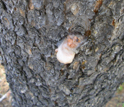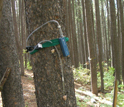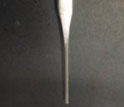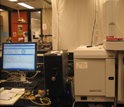News Release 12-100
Beetle-infested Pine Trees Contribute to Air Pollution and Haze in Forests
Popular summer tourist destinations may 'see' the effects
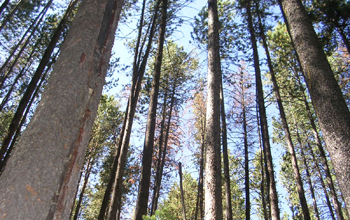
A lodgepole pine forest facing bark beetle infestation, which has far-reaching effects.
May 23, 2012
This material is available primarily for archival purposes. Telephone numbers or other contact information may be out of date; please see current contact information at media contacts.
The hordes of bark beetles that have bored their way through more than six billion trees in the western United States and British Columbia since the 1990s do more than kill stately pine, spruce and other trees.
Results of a new study show that these pests can make trees release up to 20 times more of the organic substances that foster haze and air pollution in forested areas.
A paper reporting the findings appears today in the journal Environmental Science & Technology, published by the American Chemical Society.
Scientists Kara Huff Hartz of Southern Illinois University Carbondale, Gannet Hallar of the Desert Research Institute's Storm Peak Laboratory in Steamboat Springs, Colo., and colleagues say that western North America is experiencing a population explosion of mountain pine beetles, a type of bark beetle that damages and kills pines and other trees.
The beetles bore into the bark of pine trees to lay eggs.
Gases called volatile organic compounds (VOCs) are released from the bore holes, which act as defense mechanisms against the beetles.
VOCs, however, also contribute to the smog and haze that obscures views of natural landscapes in U.S. national parks and other natural areas where tourists flock in summer.
"These results highlight one of the many potential feedbacks due to aerosols, which continue to be the greatest challenge to improving predictive models for air quality, visibility and climate," says Alex Pszenny, program director in the National Science Foundation's Division of Atmospheric and Geospace Sciences, which funded the research.
To determine how beetle attacks affect the atmosphere, the researchers measured VOC levels in the air near healthy and infected pine trees.
They found that beetle-infested trees release up to 20 times more VOCs than healthy trees near the ground surface.
The predominant type of VOC released by trees was called ß-phellandrene.
The data suggest that the bark beetle epidemic in the western United States could have led to higher concentrations of organic compounds in the air, which may contribute to haze.
The haze, say the scientists, may in turn harm human health, reduce visibility and affect climate.
Other authors of the paper are Hardik Amin and Aaron Brown of Southern Illinois University Carbondale; P. Tyson Atkins of the Desert Research Institute; Rachel Russo of the University of New Hampshire; and Barkley Sive of Appalachian State University in Boone, N.C.
-NSF-
-
Beetle infestation site on a lodgepole pine.
Credit and Larger Version -
A sampling device on a bark beetle-infested lodgepole pine tree.
Credit and Larger Version -
A tube from a device used to sample organic compounds released by pine trees.
Credit and Larger Version -
Gas chromatography/mass spectroscopy was used to analyze the samples collected.
Credit and Larger Version
Media Contacts
Cheryl Dybas, NSF, (703) 292-7734, email: cdybas@nsf.gov
Michael Woods, American Chemical Society, (202) 872-4445, email: m_woods@acs.org
The U.S. National Science Foundation propels the nation forward by advancing fundamental research in all fields of science and engineering. NSF supports research and people by providing facilities, instruments and funding to support their ingenuity and sustain the U.S. as a global leader in research and innovation. With a fiscal year 2023 budget of $9.5 billion, NSF funds reach all 50 states through grants to nearly 2,000 colleges, universities and institutions. Each year, NSF receives more than 40,000 competitive proposals and makes about 11,000 new awards. Those awards include support for cooperative research with industry, Arctic and Antarctic research and operations, and U.S. participation in international scientific efforts.
Connect with us online
NSF website: nsf.gov
NSF News: nsf.gov/news
For News Media: nsf.gov/news/newsroom
Statistics: nsf.gov/statistics/
Awards database: nsf.gov/awardsearch/
Follow us on social
Twitter: twitter.com/NSF
Facebook: facebook.com/US.NSF
Instagram: instagram.com/nsfgov



